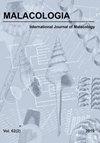Ongoing Westward Expansion of the Carpathian Blue Slug Bielzia coerulans into Central Europe
IF 1
4区 生物学
Q4 ZOOLOGY
引用次数: 0
Abstract
Increasing traffic and trade, the modification of landscapes by humans, and climate change facilitate the dispersal of certain species that are adapted to anthropogenic habitats. When species’ natural dispersal limitations are overridden by human-mediated dispersal, the composition of communities can be determined by the prevailing climate, rather than reflecting biogeographic realms, as has been shown for terrestrial snails (Capinha et al., 2015). The size of a species’ native range affects the probability that it will become invasive (Pyšek et al., 2009). Thus, endemic species with small geographic ranges rarely become invasive. Here we report a new record of the Carpathian blue slug Bielzia coerulans (Bielz, 1851) (Gastropoda: Limacidae) from the Bavarian Forest in Germany, which together with other records might indicate an ongoing expansion of this characteristic representative of the Carpathian fauna westward. The discovery of Bielzia coerulans was a fortuitous result of entomological excursions in the Bavarian Forest in southern Germany. The identification of the species was based on the external morphology (Fig. 1) in accordance with characteristics given by Wiktor (1989) and Wiese & von Glasow (2013). A single adult specimen of the Carpathian blue slug Bielzia coerulans (Fig. 1) was discovered under a large stone in the nature reserve “Pfahl bei der Ruine Weißenstein” about 800 m southeast of Regen-Weißenstein (48°56’38.87”N, 13°09’29.16”E), at 710 m a.s.l., in the Bavarian Forest in Germany on 9 August 2017 by the second author. The specimen was immediately identified by its characteristic blue colour and recorded. Further searching did not result in the discovery of additional specimens. MALACOLOGIA, 2019, 62(2): 373–375喀尔巴阡蓝蛞蝓向中欧的持续向西扩张
交通和贸易的增加、人类对景观的改变以及气候变化促进了某些适应人类栖息地的物种的扩散。当物种的自然扩散限制被人类介导的扩散所覆盖时,群落的组成可以由当时的气候决定,而不是像陆地蜗牛那样反映生物地理领域(Capinha等人,2015)。一个物种的原生范围大小会影响其入侵的可能性(Pyšek等人,2009年)。因此,地理范围较小的特有物种很少会成为入侵物种。在这里,我们报道了来自德国巴伐利亚森林的喀尔巴阡蓝蛞蝓Bielzia coerulans(Bielz,1851)(腹足目:Limacidae)的新记录,这与其他记录一起可能表明喀尔巴提亚动物群的这一特征代表正在向西扩展。在德国南部巴伐利亚森林进行昆虫学考察后,偶然发现了科氏Bielzia coerulans。该物种的鉴定基于外部形态(图1),符合Wiktor(1989)和Wiese&von Glasow(2013)给出的特征。2017年8月9日,第二作者在德国巴伐利亚森林的Regen Weißenstein东南约800米处(北纬48°56'38.87“,东经13°09'29.16”)的自然保护区“Pfahl bei der Ruine Weiłensstein”的一块大石头下发现了喀尔巴阡蓝蛞蝓Bielzia coerulans的一个成年标本(图1)。该标本立即通过其特有的蓝色进行了鉴定并进行了记录。进一步的搜索没有发现更多的标本。孔雀学,2019,62(2):373–375
本文章由计算机程序翻译,如有差异,请以英文原文为准。
求助全文
约1分钟内获得全文
求助全文
来源期刊

Malacologia
生物-动物学
CiteScore
2.00
自引率
0.00%
发文量
15
审稿时长
3 months
期刊介绍:
Malacologia publishes papers on all groups of the Mollusca. Malacologia specializes in publishing long papers and monographic treatments. Complete data are especially appreciated. Papers must be of interest to an international readership. Papers in systematics, ecology, population ecology, genetics, molecular genetics, evolution and phylogenetic treatments are especially welcomed. Also welcomed are letters to the editor involving papers published or issues of import to science of the day.
 求助内容:
求助内容: 应助结果提醒方式:
应助结果提醒方式:


